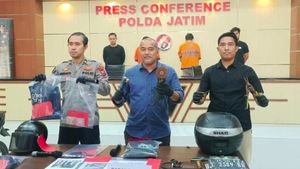Liverpool have released a statement stating that'sports integrity has been eroded' after VAR failed to rate Luis Diaz's goal as offside in their defeat at Tottenham on Saturday, September 30.
After Curtis Jones was shown a red card, Luis Diaz managed to score a goal which made his score 1-0, but his goal was misallowed due to offside.
Professional Game Match Officials Limited (PGMOL) released a statement after a match confirming that a 'human error' had occurred.
Liverpool, who played with nine players after Diogo Jota got two yellow cards, finally conceded last minute and lost 2-1 as Joel Matip broke into his own net.
The statement released on Sunday October 1 stated: "The Liverpool Football Club recognizes PGMOL's recognition of its failure last night. It is clear that the correct application of the game law did not occur, resulting in the integrity of the sport eroded."
SEE ALSO:
"We fully understand the pressure the match referees have to face, but this pressure should be overcome, not exacerbated, with the presence and application of VAR. Therefore, it is inadequate that sufficient time is not given to allow correct decisions to be taken and there is no subsequent intervention," said PGOML.
"That the failure has been categorized as a'significant human error' is also unacceptable. Each result must be determined only through a review and with full transparency."
"This is important for the reliability of future decisions and applies to all clubs, with learning used to make improvements in the process to ensure this kind of situation doesn't happen again."
The initial idea of using VAR itself is to ensure that the match runs fairly and fairly by minimizing referee errors in the field. But if VAR also can't handle the referee's mistakes, of course this will be questioned for their use.
VAR is used to assist referees in making decisions in crucial situations during football matches. Here is how VAR is used:
A review by the Main Referee: The main referee of the match can ask for VAR assistance in certain situations, such as offside determinations, violations in the penalty box, or incidents that may not be clearly seen by referees on the field.
Video Assessment: VAR Referee (Video Assistant Referee) checks replay from various camera angles to assess the debated events. They can see the show at normal and slow speeds.
Communication between Referee and VAR: Referees in the field can communicate with VAR referees through means of communication. They can receive recommendations or information from VAR.
Final Decision: The referee in the field decides whether to directly examine the situation on the side screen or receive a direct recommendation from VAR. Referees in the field still hold the final authority to make decisions.
Decision Announcement: After making the decision, referees on the ground announced final decisions to players, teams and spectators at the stadium. This often involves hand signal performances showing whether goals are awarded, penalties given, or cards issued.
The use of VAR (Video Assistant Referee) in football begins with several steps and initial preparations.
Referee Training: Referees who will operate VAR must undergo special training to understand their roles and responsibilities. This includes understanding game rules, technical understanding of the use of VAR technology, and situational exercises to identify important moments that require VAR intervention.
Technology: Technical preparation involves the hardware and software installation needed for VAR. This includes installing additional cameras in stadiums, setting up VAR control rooms, and adequate communication networks to allow collaboration between field referees and VAR referees.
Trials: Before being implemented in official matches, VARs are usually tested in friendly matches or preparation tournaments. This provides an opportunity for referees and VAR operators to practice and understand how VAR will work in real situations.
VAR Usage Procedures: Football Federation and competition authorities are developing guidelines and procedures for VAR use. This includes the situation when VAR may be used, how communication between field referees and VAR referees takes place, and how the final decision is made.
Communication with Spectators: Viewers in stadiums and television viewers should be informed about the use of VAR. This includes an explanation of the criteria for using VAR, signs of VAR being used, and the way the final decision was announced.
Official launch: After the above preparations are completed, VARs are introduced in official matches. This is usually done in stages, starting from the top league and top competitions, and then reaching lower levels.
The use of VAR aims to increase justice in football by identifying and correcting referee mistakes that may be missed in crucial situations. Although not perfect, VAR has become an important part of modern football and continues to develop
The English, Chinese, Japanese, Arabic, and French versions are automatically generated by the AI. So there may still be inaccuracies in translating, please always see Indonesian as our main language. (system supported by DigitalSiber.id)


















